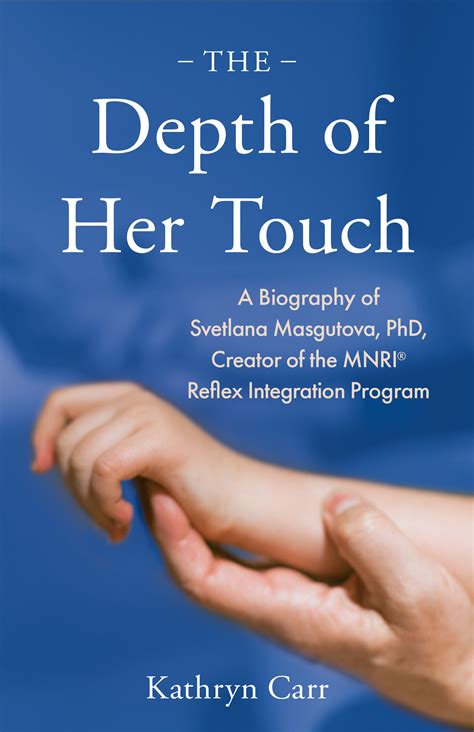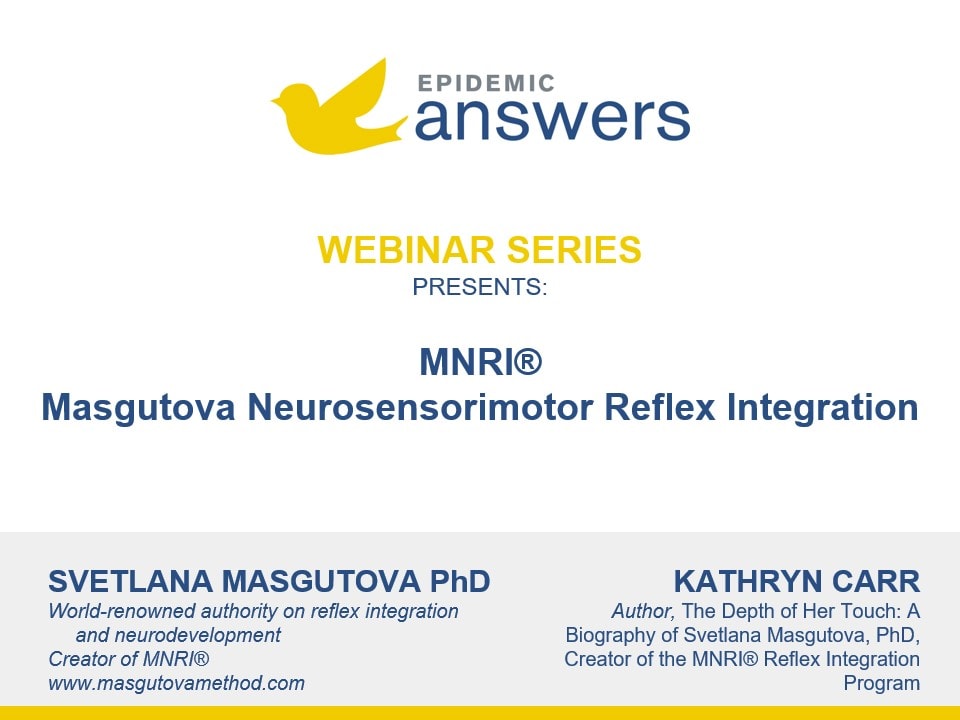The son of Kathryn Carr, the author of this book, was not the only one to make such strides. Kathryn noted that other children saw significant gains as well after having gone through the MNRI® reflex integration program:
- A child with an underdeveloped corpus callosum, poor balance, hyptonia, dyspraxia and learning challenges completed a three-year college program that allowed her to live independently.
- A child with autism and severe behavioral challenges learned to dance.
- Some children with cerebral palsy walked for the first time.
- Other children with autism spoke for the first time.
What Is MNRI®?
MNRI® (Masgutova Neurosensorimotor Reflex Integration) is a process developed by Svetlana Masgutova PhD to integrate retained primary reflexes. Also known as the Masgutova Method, MNRI® facilitates primary reflex integration through specific depths of proprioceptive touch and movement. Integrated reflexes are the foundation of human development and survival.
“Primary reflex patterns are the building blocks for human development and serve as subordinate roles to more-complex automatic motor-reflex schemes and learned motor skills. If these primary reflexes do not emerge, develop, mature, and integrate naturally, a child can have physical, cognitive, social, and emotional challenges.
If the basic reflex pattern is incorrect, the body will signal a dysfunction or deeper pathology within some reflex pattern component. As a result, the child remains in a state of ‘negative protection,’ meaning they continue to exhibit emotional dysregulation or various atypical movements and behaviors.”
Children with the following conditions often have retained primary reflexes:
- Attention Deficit Disorders (ADD and ADHD)
- Autism Spectrum Disorder
- Cerebral palsy
- Developmental delays
- Down Syndrome
- Dyslexia
- Dyspraxia and apraxia
- Hyperlexia
- Hypotonia and hypertonia
- Hypoxic-ischemic encephalopathy
- Learning disability
- Lyme disease
- Nonfatal drowning
- PANS/PANDAS
- Sensory Processing Disorder
- Speech and language issues
- Strabismus and amblyopia
- Toe walking
- Trauma survival
MNRI® is part of Documenting Hope’s FLIGHT™ Study, which aims to test the hypothesis that comprehensive personalized lifestyle interventions will result in symptom abatement, improved health and potentially full diagnosis reversal. Heather Tallman-Ruhm MD, the medical director of the Documenting Hope Projects says that “(Masgutova’s) work has given us another validated tool to assess, measure, and support a bio-individualized and carefully sequenced intervention plan for children with modern chronic illnesses.”
Who Is Svetlana Masgutova PhD?
Svetlana Masgutova PhD is a world-renowned authority on reflex integration and neurodevelopment. She earned a PhD in psychology in 1988 in Russia and a post-graduate degree in clinical neuro-speech development in Poland. She is the author of more than 200 published books and articles on psychology, education, neurosensorimotor reflex integration and sensorimotor-based development.
Dr. Masgutova was heavily influenced by the work of Ivan M. Sechenov, who had groundbreaking work in the understanding of reflex reactions. He was known as the patriarch of Russian neurophysiology; he proved the central nervous system controlled whether a reflex action could occur. Psychologist Lev S. Vygotsky, physiologist Ivan P. Pavlov, endocrinologist Hans Selye, psychiatrist Elisabeth Kubler-Ross, neurophysiologist Nikolai A. Bernstein and physiologist Walter Cannon all also played a role in her work and understanding of the integration of retained primary reflexes.
Vygotsky’s work in particular was the basis for the development of MNRI® because he believed that “there is no ceiling in the development of a human.”
Originally hailing from the Kirgiz-Miyakinsky District in the Bashkortostan Republic of Russia, Dr. Masgutova is the great-granddaughter of an osteopathic village healer. She wanted to be a body-oriented psychologist since she was an early teen.
She is imbued with her family’s values of serving those who are sick, vulnerable, or suffering. Her father told her that, “You must always help someone who is in need or cannot speak for themselves. You must help anyone vulnerable until your very end.” These values, as well as her personal life tragedies, filled her with compassion and empathy.
She realized that her life’s purpose is to help survivors of stress and trauma as well as people with neurodevelopmental challenges after her four months of working with children who were injured in the 1989 Ufa train accident. In her work with these children, she realized that talk therapy retraumatized them. Instead, she developed in real time reflex-integration techniques with hands-on neuromodulation techniques she learned from her great-grandparents..
It is her work with trauma survivors of Ufa, Chernobyl and Sandy Hook that informed her insights into primary reflex integration. Those with retained reflexes are often in a state of trauma and have an ongoing fight-or-flight response. In order for the brain and body to heal, the body needs to know that it is safe. This is the foundation of MNRI®.
What’s in the Book?
Although this book is a biography of Dr. Masgutova’s life (so far), it also contains:
- Explanations of what primary reflexes are
- Examples of common retained reflexes
- Discussions of problems that can arise from retained reflexes
- Causes of retained reflexes
- Testimonials from professionals who participated in the course
- Testimonials from parents whose children went through the MNRI® course
- Personal history of Dr. Masgutova detailing how and why she developed MNRI®
This book is useful for those wishing to understand how and why Dr. Masgutova developed her unique healing program. The personal stories and testimonials can serve as a gentle introduction to the program. Those wishing detailed instructions and exercises for MNRI® reflex integration can get more information from the numerous books that Dr. Masgutova has written (see Resources, below), her websites (see Resources, below), the MNRI® therapists that she has trained and/or live events that she hosts.
Kathryn Carr is a proud parent of an MNRI® child and an award-winning print journalist. She has served as a longtime project editor and writer for Crain’s Cleveland Business. She also is a contributing editor for the Svetlana Masgutova Educational Institute.
During her journalism career, Kathryn oversaw the editorial team for Edible Cleveland, which was named one of Ohio’s top magazines. She also was a copy editor and designer for the Pensacola (Fl.) News Journal and collaborated on a newsroom reporting project that was nominated for a Pulitzer Prize.
Kathryn earned a master of fine arts degree in journalism from Kent State University in Ohio. She and her family live in northeast Florida, and she is passionate about helping to advance the awareness and visibility of the MNRI® / Masgutova Method.

Still Looking for Answers?
Visit the Epidemic Answers Practitioner Directory to find a practitioner near you.
Join us inside our online membership community for parents, Healing Together, where you’ll find even more healing resources, expert guidance, and a community to support you every step of your child’s healing journey.
Sources & References
Amos, P. Rhythm and timing in autism: learning to dance. Front Integr Neurosci. 2013 Apr 19;7:27.
Barnhill, E. Neural connectivity, music, and movement: a response to Pat Amos. Front Integr Neurosci. 2013 Apr 24;7:29.
Akhmatova, N.K., et al. Influence of MNRI on the Immune Status of Children with Down Syndrome. Journal of Clinical & Cellular Immunology. 8 (2017): 1-8.
Bell, C., et al. The Effect of the MNRI Method on Neurotransmitter Biomarkers of Individuals with Neurodevelopmental Disorders. Neuroscience and Medicine. 2019.
Cho, H., et al. Effects of Action Observation Training with Auditory Stimulation on Static and Dynamic Balance in Chronic Stroke Patients. J Stroke Cerebrovasc Dis. 2020 May;29(5):104775.
Deiss, T., et al. Physiological Markers and Reflex Pattern Progression in Individuals with Neurodevelopmental Deficits Utilizing the MNRI Method. Neuroscience and Medicine. 2019.
Grigg, T.M., et al. Retained primitive reflexes: Perceptions of parents who have used Rhythmic Movement Training with their children. J Child Health Care. 2018 Sep;22(3):406-418.
Grzywniak, C. Integration exercise programme for children with learning difficulties who have preserved vestigial primitive reflexes. Acta Neuropsychologica. 2017;15(3).
Hardy, M.W., et al. Rhythm, movement, and autism: using rhythmic rehabilitation research as a model for autism. Front Integr Neurosci. 2013 Mar 28;7:19.
Herbert, J., et al. Crawling is associated with more flexible memory retrieval by 9-month-old infants. Dev Sci. 2007 Mar;10(2):183-9.
Hong, H.J., et al. Effect of Rhythmic Movement Program to Improve Walking Ability for Elderly Patients with Stroke. Indian Journal of Science and Technology. 2016 Jul;9(26).
Iverson, J.M. Developing language in a developing body: the relationship between motor development and language development. J Child Lang. 2010 Mar;37(2):229-61.
Jordan-Black, J. The effects of the Primary Movement programme on the academic performance of children attending ordinary primary school. Journal of Research in Special Educational Needs. 2005 Nov;5(3):101 – 111.
Kadivar, Z., et al. Effect of step training and rhythmic auditory stimulation on functional performance in Parkinson patients. Neurorehabil Neural Repair. 2011 Sep;25(7):626-35.
Ladányi, K. et al. Is atypical rhythm a risk factor for developmental speech and language disorders? Wiley Interdiscip Rev Cogn Sci. 2020 Sep;11(5):e1528.
Lakatos, P., et al. A New Unifying Account of the Roles of Neuronal Entrainment. Curr Biol. 2019 Sep 23;29(18):R890-R905.
Masgutova, S., et al. Effect of the MNRI Reflex Neuromodulation on the QEEG and Neurotransmitters of Children Diagnosed with Cerebral Palsy. 2020.
Masgutova, S., et al. Effects of MNRI Visual Reflex Neuro-Training on Visual and Academic Skills of Children with Autism. International Journal of School and Cognitive Psychology 05 (2018): 1-15.
Masgutova, S. Post-Trauma Recovery in Children of Newtown, CT using MNRI Reflex Integration. Journal of
Traumatic Stress Disorders & Treatment. 5(5) 2017.
Masgutova, S., et al. Reflex Profile of Children with Down Syndrome Improvement of Neurosensorimotor Development Using the MNRI® Reflex Integration Program. International Journal of Neurorehabilitation. 3 (2016): 1-9.
Masgutova, S., et al. Progress with Neurosensorimotor Reflex Integration for Children with Autism Spectrum Disorder. 2016.
Masgutova, S. Reflex Integration Disorder as a New Treatment Paradigm for Children with Autism. 2015.
McWhirter, K., et al. The association between learning disorders, motor function, and primitive reflexes in pre-school children: A systematic review. J Child Health Care. 2022 Jul 13;13674935221114187.
Melillo, R., et al. Persistent Childhood Primitive Reflex Reduction Effects on Cognitive, Sensorimotor, and Academic Performance in ADHD. Front Public Health. 2020 Nov 17;8:431835.
Mohamed, M.A., et al. Sensory integration versus Masgutova neuro-sensorimotor reflex integration program on controlling primitive reflexes and gross motor abilities in children with diplegic cerebral palsy. Physiother Res Int. 2023 Jun 29;e2030.
Nowak, K., et al. Evaluation of the Therapeutic Effect of MNRI Reflex Neuromodulation on Children Diagnosed with Autism Based on Reflex Assessments, QEEG Analysis and ATEC Questionnaire. 2020.
Pilecki, W., et al. The impact of rehabilitation carried out using the Masgutova Neurosensorimotor Reflex Integration method in children with cerebral palsy on the results of brain stem auditory potential examinations. Adv Clin Exp Med. 2012 May-Jun;21(3):363-71.
Schmidt, N.B., et al. Exploring human freeze responses to a threat stressor. J Behav Ther Exp Psychiatry. 2008 Sep;39(3):292-304.
Suh, J.H., et al. Effect of rhythmic auditory stimulation on gait and balance in hemiplegic stroke patients. NeuroRehabilitation. 2014;34(1):193-9.
Tatarinova, T.V., et al. The Impact of MNRI Therapy on the Levels of Neurotransmitters Associated with Inflammatory Processes. Int J Mol Sci. 2020 Feb 18;21(4):1358.
Van Hirtum, T., et al. Is atypical rhythm a riskfactor for developmental speech and language disorders? J Assoc Res Otolaryngol. 2021 Jul;22(4):465-480.
Winkler, I., et al. Newborn infants detect the beat in music. Proc Natl Acad Sci U S A. 2009 Feb 17;106(7):2468-71.
Zaigham, M., et al. Prelabour caesarean section and neurodevelopmental outcome at 4 and 12 months of age: an observational study. BMC Pregnancy and Childbirth. 2020 (20)564.
Zentner, M., et al. Rhythmic engagement with music in infancy. Proc Natl Acad Sci U S A. 2010 Mar 30;107(13):5768-73.
Resources
Articles
Svetlana Masgutova Educational Institute: What can make reflexes dysfunctional.
Books
Blomberg MD, Harald and Dempsey, Moira. Movements That Heal, Rhythmic Movement Training and Primitive Reflex Integration. Independenly published, 2011.
Brandes, Bonnie. The Symphony of Reflexes: Interventions for Human Development, Autism, ADHD, CP, and Other Neurological Disorders. CreateSpace Independent Publishing Platform, 2016.
Dennison, Paul E., et al. Brain Gym: Simple Activities for Whole Brain Learning. Edu Kinesthetics. June 1, 1992.
Goddard Blythe, Sally. The Well Balanced Child: Movement and Early Learning. Hawthorn Press, 2005.
Goddard, Sally. Reflexes, Learning and Behavior, A Window Into the Child’s Mind. Fern Ridge Press, 2005.
Carr, Kathryn. The Depth of Her Touch: A Biography of Svetlana Masgutova, PhD, Creator of the MNRI® Reflex Integration Program. Svetlana Masgutova Educational Institute. September 1, 2023.
A Collective Work. Reflexes: Portal to Neurodevelopment and Learning. Svetlana Masgutova Educational Institute, LLC; First Edition. January 1, 2015.
Masgutova, Denis, et al. Parents’ Guide to MNRI® Masgutova Neurosensorimotor Reflex Integration. Svetlana Masgutova Educational Institute, LLC; First Edition. January 1, 2015.
Masgutova, Svetlana, et al. Autism: Maximize Potential with MNRI® Reflex Integration. Svetlana Masgutova Educational Institute; First Edition. January 1, 2023.
Masgutova, Svetlana, et al. MNRI® Reflex Integration for Your Daily Well-Being. Svetlana Masgutova Educational Institute, LLC. January 1, 2020.
Masgutova, Svetlana, et al. Post Trauma Recovery: Gentle, Rapid, and Effective Treatment with Reflex Integration. 1st World Publishing. January 17, 2018.
Masgutova, Svetlana, et al. Trauma Recovery – You Are A Winner; A New Choice Through Natural Developmental Movements. 1st World Publishing. May 24, 2007.
Websites
Balance Brain Achievement Centers
Institute for Neuro-Physiological Psychology
My Child Will Thrive: Primitive Reflexes Cheat Sheet




